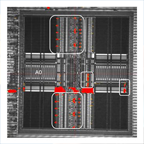Virtual lab advances DOD's ability to test critical microelectronics

Under the auspices of DARPA's Integrity and Reliability of Integrated Circuits program, researchers from the Naval Surface Warfare Center (NSWC) and Air Force Research Laboratory (AFRL) are collaborating in powerful new ways to determine the reliability and integrity of microchips embedded in the some of the nation's most critical military weapon and cyber systems.
Integrated circuits or microchips are ubiquitous, found in virtually all modern appliances and systems ranging from desktop computers, laptops and cell phones to fighter aircraft and munitions. Despite that pervasiveness and criticality, few automated techniques today can verify whether the intended functionality of microchips has been compromised at any stage during design and fabrication.
To ensure performance of integrated circuits in military systems, DARPA, working in concert with its Service partners, developed a "virtual lab" with an integrated computer-aided design or CAD and file-sharing environment to transfer the large volumes of data accumulated during microchip analysis and debugging. In addition to file sharing, a website constructed for the virtual lab is facilitating communication between government researchers and program performers from academia and industry.
"Integrated circuits or microchips form the backbone of all military IT and electronics systems, and ensuring that these microchips are free from unauthorized tampering is essential to national security. Unfortunately, this task has become increasingly difficult as more microchips are designed and built around the world in commercial facilities," said Kerry Bernstein, DARPA program manager. "Improving chip intrusion detection and assessment speed across the investigative community will help prevent the installation of counterfeit chips in military systems and enhance overall confidence in the electronics supply chain."
DARPA's virtual lab is creating new methods for researchers to test electronic systems with substantial complexity, giving rise to innovative reliability analysis tools. These tools are applied to test articles distributed by DARPA to its performers, who stress the chips under loads likely to be seen during normal operating conditions.
One test, referred to as advanced failure analysis, uses state-of-the-art equipment, including multiple scanning optical microscope techniques transferred earlier this year from DARPA to NWSC. In a recent investigation conducted by NSWC Crane, AFRL Wright Patterson and University of Southern California's Information Sciences Institute, researchers devised a proprietary, non-destructive technique to analyze and repair microchips exhibiting erratic behavior. Using this novel failure analysis tool, the team was able to determine the precise design fault responsible for the behavior and correct the problem. The non-invasive testing was conducted using an innovative 1340nm laser application to physically alter the chip's circuitry. Traditionally, a focused ion beam (FIB) edit would have been required to conduct such a repair, risking destruction of the chip and its components. The new technique preserves functionality of the part and its use as evidence in subsequent forensic analyses.
"As we seek to authenticate, fix and/or remove suspected counterfeit microchips through these efforts, broadening the availability of non-invasive tools, techniques and related findings across the DoD is essential," said Bernstein. "Given how widespread microchips are, and their vulnerability to compromise, the numbers don't seem to be on our side. Through the virtual lab, however, we can help shift the balance in our favor. By extending testing resources to our Service partners and working together more effectively, we can ensure the reliability of our most important electronic systems."
Provided by DARPA





















